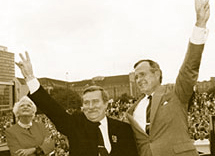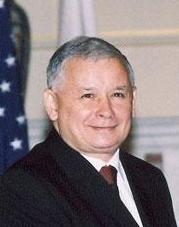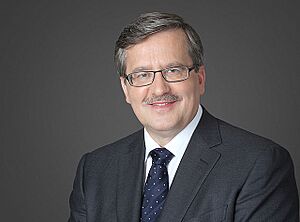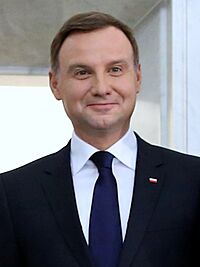History of Poland (1989–present) facts for kids
From 1989 to 1991, Poland went through a big change. It moved from a communist government, called the Polish People's Republic, to a democratic one. This new democratic government is known as the Third Polish Republic (Polish: III Rzeczpospolita Polska). It followed the First and Second Polish Republic. After ten years of building its democracy, Poland joined NATO in 1999. It then joined the European Union on May 1, 2004.
Contents
Poland's Journey to Freedom
Tension grew between the people of Poland and its communist government. This was happening in other countries in the Eastern bloc too. The power of the Soviet Union was fading away. A new idea called perestroika started in the Soviet Union. This gave Poland a chance to change its government system. This happened after a tough time of martial law from 1981 to 1983. General Wojciech Jaruzelski had put this martial law in place.
Round Table Talks and New Beginnings
The government could not stop Poland's economy from getting worse. This led to many strikes across the country in 1988. To try and control the situation, the government officially recognized the Solidarity union. The Interior Minister, Czesław Kiszczak, started talks with Solidarity's leader, Lech Wałęsa, on August 31.
These first talks stopped in October. But new talks, called the "round table" talks, began in February 1989. These talks led to an agreement in April for partly open parliamentary elections. The election in June created a new Sejm (the lower house of parliament). One-third of the seats went to the communist party. Another third went to two parties that had worked with them. The last third of the seats in the Sejm and all seats in the Senate were open for anyone to win. Most of these were won by candidates supported by Solidarity.
The communist party did not do well in the elections. This caused a political problem. The round-table agreement said there should be a communist president. So, on July 19, the National Assembly elected General Wojciech Jaruzelski as president. Some Solidarity members supported this. However, the communists tried twice to form a government, but they failed.
On August 19, President Jaruzelski asked Tadeusz Mazowiecki to form a government. Mazowiecki was a journalist and Solidarity activist. On September 12, the Sejm approved Prime Minister Mazowiecki and his team. For the first time in over 40 years, Poland had a government not led by communists.

In December 1989, the Sejm approved a plan to quickly change Poland's economy. It moved from being controlled by the state to a free market. They also changed the constitution to remove mentions of the Communist Party's "leading role." The country was renamed the "Republic of Poland." The communist Polish United Workers' Party ended in January 1990. A new party, Social Democracy of the Republic of Poland, took its place. Most of the old Communist Party's property went to the state.
The local elections in May 1990 were completely free. Candidates supported by Solidarity's Citizens' Committees won most of the elections they entered. But only a little over 40% of voters participated. The government team was changed in July 1990. The ministers for national defense and interior affairs were replaced. These had been from the old communist government.
In October 1990, the constitution was changed to shorten President Jaruzelski's term. In December, Lech Wałęsa became the first president of Poland chosen by the people.
Wałęsa's Time as President (1990–1995)
In the early 1990s, Poland made good progress. It moved towards a democratic government and a market economy. In November 1990, Lech Wałęsa was elected president for five years. At Wałęsa's request, Jan Krzysztof Bielecki became Prime Minister. He served until October 1991. He introduced world prices and greatly increased private businesses.
Poland's first free parliamentary elections were held in 1991. More than 100 parties took part, showing many different political ideas. No single party won more than 13% of the votes. The government led by Prime Minister Jan Olszewski was Poland's first fully free and democratic government since 1926. This government was supported by the Kaczyński brothers. Olszewski was later replaced by Hanna Suchocka in 1992. She became the first woman Prime Minister of Poland. This happened after a politician wanted to reveal names of people who had worked with the communist secret police.
After a difficult start, 1993 saw the second group of elections. This parliament was the first to serve a full term. The Democratic Left Alliance (SLD) received the most votes. Also in 1993, the Soviet Northern Group of Forces finally left Poland.
After the election, the SLD and Polish People's Party (PSL) formed a government together. Waldemar Pawlak, the leader of the PSL, became Prime Minister. Relations between President Wałęsa and Prime Minister Pawlak were not good. The President said Pawlak cared more about himself and his party than about the country. After some problems involving Pawlak and growing political tension, Wałęsa asked Pawlak to resign in January 1995. The government group then removed Pawlak. They replaced him with Józef Oleksy from the SLD as the new Prime Minister.
Kwaśniewski's Time as President (1995–2005)

In November 1995, Poland held its second free presidential elections since the war. The SLD leader, Aleksander Kwaśniewski, won against Wałęsa by a small amount. Soon after Wałęsa's loss, the Interior Minister accused Prime Minister Oleksy of working with Soviet and Russian intelligence for a long time. Oleksy resigned during this political problem. The SLD-PSL group chose Włodzimierz Cimoszewicz as his replacement. He was connected to the SLD but not a member. Later, prosecutors decided there was not enough proof to charge Oleksy. A group in parliament also said that Polish intelligence might have broken rules when gathering evidence in Oleksy's case.
Poland's new Constitution in 1997 changed how the idea of the Polish nation was defined. It focused on shared citizenship rather than ethnic background. Article 35 made sure that the rights of national and ethnic minorities were protected. Other parts of the constitution stopped discrimination and political groups that spread hatred based on race.
In the 1997 parliamentary elections, two parties linked to the Solidarity movement won many seats. These were Solidarity Electoral Action (AWS) and the Freedom Union (UW). They won 261 out of 460 seats in the Sejm and formed a government together. Jerzy Buzek from AWS became Prime Minister. The AWS and the Democratic Left Alliance (SLD) held most of the seats in the Sejm. Marian Krzaklewski led the AWS, and Leszek Miller led the SLD. In April 1997, Poland's first constitution since the communist era was finished. It went into effect in July. In June 2000, UW left the government group. This left AWS in charge of a government with fewer members.
In the presidential election of 2000, Aleksander Kwaśniewski was re-elected. He was the current president and former leader of the SLD. He won in the first round with 53.9% of the votes. Second place went to Andrzej Olechowski, with only 17.3%. People thought the opposition's campaign was weak. They could not find a strong candidate. Also, support for the AWS government was falling. This was due to problems within the ruling group in parliament.
The 1997 Constitution and new way of dividing regions in 1999 meant the election system needed changes. These changes were passed in April 2001. Important changes included:
- Ending the party list system. Before, some members of parliament were chosen from a party list based on national support. Now, they were chosen from local areas.
- Changing how seats were given out to parties. This new method gave less advantage to large parties. This change was reversed in 2002.
In the September 2001 parliamentary elections, the SLD won a big victory. Voters were unhappy with the AWS government and its internal fights. The AWS, the former ruling party, did not even get into parliament. This was because they fell below the 8% rule for groups of parties. They had not formed a single political party, which only has a 5% rule.
The SLD then formed a government with the farming party PSL and the leftist Labour Union (UP). Leszek Miller became Prime Minister. This government had the support of 256 out of 460 seats in the Sejm.
A main topic in the following years was talking with the European Union about joining. Poland also prepared itself for this. Poland joined the EU on May 1, 2004. Both President Kwaśniewski and the government strongly supported joining. The only party clearly against joining the EU was the right-wing League of Polish Families (LPR).
Even though most people wanted to join the EU, the government quickly lost popularity. This was because of problems with things like building highways and a failed health system reform. There were also many corruption scandals.
In March, some important SLD politicians left the party. They formed a new party called Social Democracy of Poland. This included the Speaker of the Sejm, Marek Borowski. The government led by Leszek Miller resigned on May 2, 2004. This was right after Poland joined the European Union.
A new government was formed with Marek Belka as Prime Minister. After two tries, it finally got support from parliament on June 24. It governed until the parliamentary elections in late 2005. Some of the new ministers were seen as experts, not tied to a party. The government was thought to be much better than the last one. However, this did not make voters support the SLD more. This was true even though the economy improved in 2005. One reason was that this government was seen as separate from the main party. It was only kept in power because most members of parliament feared early elections.
This fear was not wrong. The SLD saw its support drop by three-fourths to only 11% in the next elections.
Lech Kaczyński's Time as President (2005–2010)
PiS-led Government (2005–2007)


In the autumn of 2005, Poles voted in elections for both parliament and president. The parliamentary election in September was expected to create a government of two center-right parties: PiS (Law and Justice) and PO (Civic Platform). But during the tough campaign, PiS strongly criticized the economic plans of their allies. PiS then became more popular in surveys. PiS finally won 27% of the votes and became the largest party in the Sejm. PO was second with 24%. The outgoing ruling party, the SLD, only got 11%. This showed a pattern: in every free election, Polish voters chose against the current government. They voted left in 1993 and 2001, and right in 1997 and 2005.
The presidential elections in October followed a similar path. The early favorite, Donald Tusk, leader of PO, lost his lead in surveys. He was beaten 54% to 46% in the second round by the PiS candidate, Lech Kaczyński. He was one of the twin brothers who founded the party.
Both elections had low voter turnout. Only 51% voted in the second round of the presidential election. Just over 40% voted in the parliamentary election. People thought this was because voters were tired of politicians.
Talks to form a government happened at the same time as the presidential elections. However, the harsh campaign and PiS's way of seeking popular votes had made the relationship between the two largest parties bad. This made it impossible to form a stable government together. PiS insisted on controlling all law enforcement, like the Justice and Internal Affairs Ministries. They also pushed for a PiS candidate to lead the Sejm with help from smaller parties. PO decided to be in the opposition.
PiS then formed a government with fewer members. Kazimierz Marcinkiewicz, who was not well-known before, became Prime Minister. The party leader, Jarosław Kaczyński, stayed powerful behind the scenes. This government relied on the quiet support of smaller parties like Samoobrona and LPR.
The new government was quite popular at first. Meanwhile, the popularity of the smaller parties supporting it went down a lot. A problem in parliament seemed likely in January 2006. The smaller parties feared that PiS would force new elections. They thought they would lose in these elections. But the problem was avoided.
In May 2006, PiS, Samoobrona, and League of Polish Families (LPR) agreed to form a government with a majority. In July 2006, after a disagreement with his party leader, Jarosław Kaczyński, Marcinkiewicz resigned as Prime Minister. Jarosław Kaczyński replaced him. The new government changed Poland's foreign relations with the EU. They took a more cautious view of the EU. Past Polish governments had been very supportive of the EU.
The difficult partnership between the three groups ended in July 2007. Andrzej Lepper, the leader of Samoobrona, was removed from his job as Minister for Agriculture. This followed a secret investigation by a special anti-corruption office. The office tried to link him and his department to corruption. Lepper said he was innocent. He claimed it was a political trap set by Prime Minister Kaczynski and PiS. The government agreement broke down over the next month. Both LPR and Samoobrona made accusations against PiS. In September, the Sejm voted to end its term. PiS supported this, but Samoobrona and LPR did not. This led to elections in October.
Donald Tusk's First Government (2007–2014)

In the October parliamentary elections, the Civic Platform (PO), the largest opposition party, won more than 41% of the votes. PiS's votes increased from 2005, but not enough to win re-election. Both Samoobrona and LPR lost all their seats. Each got only a little over 1% of the votes. PO then formed a government with the farming party Polish People's Party (PSL). Donald Tusk, the PO leader, became Prime Minister in November 2007.
On August 14, 2008, the United States and Poland agreed on a plan. Ten missile interceptors would be placed in Poland. This was part of a missile shield to protect Europe and the US from possible missile attacks by Iran. In return, the US agreed to move MIM-104 Patriot missiles to Poland. US military people would operate these missiles, at least for a while. The US also promised to defend Poland, a NATO member, faster than NATO would in case of an attack. After the agreement, Russian officials, who saw the missile shield as a threat, made a statement. They indirectly threatened Poland. They said the missile defense system would greatly harm future US/Russia relations.
Russia later threatened a nuclear attack against "new US assets in Europe," meaning Poland. The US promised to support Poland if Russia acted aggressively towards it.
Komorowski's Time as President (2010–2015)

On April 10, 2010, many important Polish leaders died in the Smolensk air crash. This included Lech Kaczyński, who was the President of Poland at the time. In the 2010 Polish presidential election, Donald Tusk decided not to run. In the PO party elections, Bronisław Komorowski won against the Foreign Minister Radosław Sikorski. In the second round of voting on July 4, 2010, he defeated PiS's Jarosław Kaczyński. On August 6, 2010, he officially became president. In the local elections in November 2010, PO won 31 percent of the votes and PiS 23 percent. This was an increase for PO and a drop for PiS compared to the 2006 elections.
In October 2011, Donald Tusk became the first Polish Prime Minister to be re-elected since the end of communism. PO won a record four elections in a row. PO's strong position was seen as a result of divisions on the right-wing, with PiS splitting in autumn 2010.
Duda's Time as President (2015–Present)

After two rounds of elections in May 2015, the opposition candidate from Law and Justice (PiS), Andrzej Duda, became President. He won by a 3% difference. In October 2015, PiS won enough seats to form the first single-party government since 1989.
Since PiS controls the presidency and has a majority in both parts of parliament, it aims to make changes to the Constitutional Court.
In December 2017, Mateusz Morawiecki became the new Prime Minister. He took over from Beata Szydlo, who had been in office since 2015. Both represented the ruling Law and Justice party, led by Jaroslaw Kaczynski.
Poland's ruling Law and Justice party (PiS) won the parliamentary election in October 2019.
Duda was re-elected in the 2020 presidential election.
In December 2023, Donald Tusk became the new Prime Minister. He took over from Morawiecki. Tusk leads a group of three parliamentary groups: Civic Coalition, Third Way, and The Left. Law and Justice became the main opposition party.
See also
 In Spanish: Polonia para niños
In Spanish: Polonia para niños
- Politics of Poland
- Fourth Polish Republic



